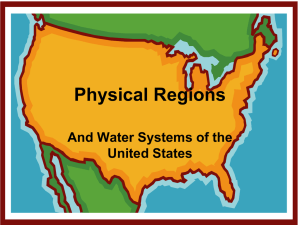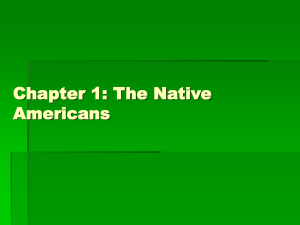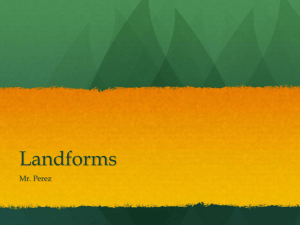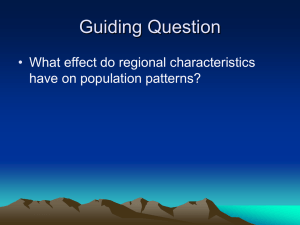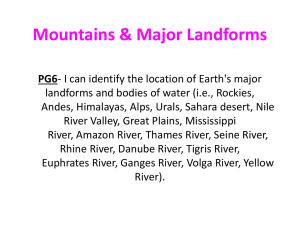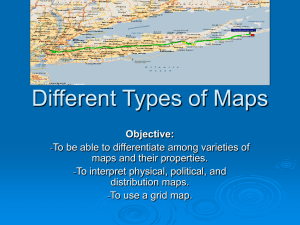File - Geography World of Jaydeep Mehta
advertisement
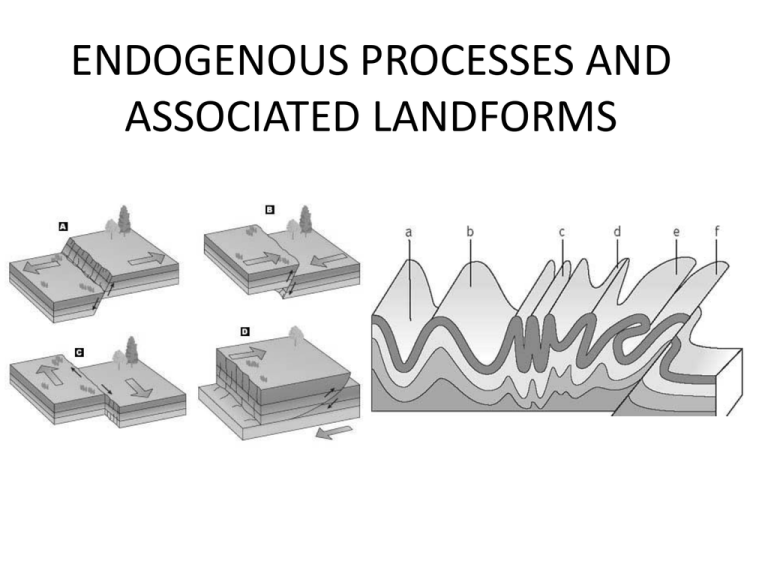
ENDOGENOUS PROCESSES AND ASSOCIATED LANDFORMS THE EVER CHANGING LANDSCAPE • • • • • • Earth’s surface is ever changing Endogenous processess- interior of the earth Mountains, plateaus and plains formed Occurences of volcanoes and earthquakes Processess- slow and sudden Many areas rise or subside NOTABLE CHANGES • • • • Breaking of Gondwanaland 120 mya Indian peninsula started drifting towards north Took present shape around 40 mya Raising of Himalayas- present height during last 1 million years. FORCES OF DIASTROPHISM • • • • Folding Faulting Uplift Depression – Act Very slowly – Effects visible after thousands of years • Two types of diastrophism – Vertical forces – Horizontal Forces VERTICAL FORCES • Continental rise and sink – Upward forces- Uplift – Downward forces- Subsidence • Do not disturb the horizontality of rock layers • At the most, layers may be inclined or tilted. HORIZONTAL FORCES • Mountain- building forces • Act in a horizontal direction • Disturb horizontal layers of rocks – Compression- body pushed from opposite sides – Tension- Rocks are pulled apart FOLDING • • • • • Bending of horizontal layers of rocks Tilting or twisting of rock strata Caused by compression Formation of series of crests and troughs Anticlines & synclines – Anticlines- limbs incline in different directions – Synclines- limbs incline in same direction TYPES OF FOLDS • Symmetrical folds- both limbs equally bent, inclined at almost equal angles to the horizontal. • Asymmetrical folds- one limb pushed too far, one side gradual slop, other side steeper • Monoclinal fold- one fold is vertical • Isoclinal fold- both sides are inclined in the same direction • Recumbent fold- one limb is pushed over the other, both limbs are parallel to each other • Overthrust fold- fracture occurs, one limb slides forward over the other limb. FAULTING • Result of tension • Rock strata cannot withstand tension, breaks • Displacement along the fault plane. – Normal Fault- blocks move in opposite direction, fault plane has steep slope – Reverse Fault- produced by compression, hanging wall slips up, gentle fault plane – Thrust Fault- one block thrusts upon the other, may result in formation of folds LANDFORMS ASSOCIATED WITH ENDOGENOUS PROCESSES • First Order Landforms- continents and oceans • Second Order Landforms- mountains, plateaus and plains • Third Order Landforms- hills, valleys, deltas etc • Mountains- 26% • Plateaus- 33% • Plains- 41% MOUNTAINS • Uplifted part of the earth from the surrounding area • At least 900 m asl, broad base, very high, steep slope and narrow peak. • Less than 900 m, landforms are called hills – Fold – Block – Volcanic – Dissected Fold Mountains • Folding of sedimentary rock strata • These were located in areas of narrow, elongated seas or lake basins- geosynclines • Either folded from both sides • Or one edge may be stable, other side is moving which may squeeze the sediment – Old Fold mountains – Young Fold Mountains Block Mountain • Formed due to creation of faults caused by tension • Block mountains and grabens • Flat tops, steep sides, flat bottomed rift valleys Volcanic Mountains • Lava thrown out and deposited around the crater forming a mountain • Also known as mountains of accumulation • Thinner lava ( Basic), shield volcano • Thicker lava( Acidic), conical volcano Dissected Mountains • Eroded by dynamic agents • Worn down from previously elevated regions – Nilgiris – Girnar – Rajmahal Hills Influence of mountains on humans • Climate- climate barriers • Vegetation- variety of forests, rich timber, pastures, raw materials for agro-based industries • Minerals- Coal, Iron ore, gold, silver, gems, oil • Rivers- source in he mountains, perennial, form fertile alluvial plains • Hydro-electricity• Health and Tourist resorts • Political boundaries- international boundaries, controversial, lost much of their significance • Defence- not completely effective, passes are used • Agriculture- terraced cultivation- valleys PLATEAUS • • • • Elevated area compared to surrounding areas Large flat top, steep cliffs, also called table land Layered with sandstones, shales and limestones Rivers and streams cut deep valleys and canyons in this region, changes it into a dissected plateau • Average height- 300 to 1000 m above sea level Types of Plateaus • Intermontane- partly or fully enclosed by mountains– Tibet, Bolivia and Mexico • Piedmont- foot of a mountain, plain or sea on the other side – Patagonian Plateau, Appalachian Plateau, Malwa Plateau • Continental- Surrounded by seas or plains, formed due to continental uplift, quite vast – Plateaus of Brazil, South Africa, South India, Arabian Peninsula Influence of Plateaus on humans • 33% of earth’s surface, 9% of population • Climate- Cooler climates in Torrid Zone, high altitudes • Agriculture- Deccan Plateau, volcanic soil • Minerals- Chotanagpur plateau- coal and iron ore, Australian Plateau- gold, silver, manganeese, Brazilian Plateau- iron ore and manganese, Bolivian Plateau- tin deposits • Transport- not well developed • Hydro-electricity- rapids on rivers • Pastures- arid climates, grass grows well, Patagonia, Turkey and South African Plateaus PLAINS • Relatively flat and low lying surface • Some of them are rolling plains, some located at very high altitudes. – Mississippi plains- 30 m to 1500 m either side – Ganga Plains- 6 to 8 m to 200 m above sea level – Kashmir lake plain- 1700 m above sea level Types of Plains • Structural plains- coastal areas, upliftment of continental shelf • Erosional Plains- formed due to erosion of elevated land- Peneplains, Karst Plains, plains of glacial erosion, Desert plains • Depositional Plains- Deposition of material in lowlands, most plains in this category – – – – Alluvial- deposition by rivers- bhabhar, bhangar, khadar Loess- deposition by wind Coastal- deposition by sea waves Lava plains- thin lava, spreads wide Influence of Plains on humans • Old civilizations, cradles of civilization • Agriculture- easy to irrigate, 85% of worlds agricultural produce comes from 41 % of world’s plain areas • Transport- Flat terrains, waterways also developed apart from roads and railways • Population- 90% world’s population live here, rapid pace of urbanization and industrialization • Industries- large scale growth, cheap labour, ready markets, lack mineral resources • Urbanization- favourable conditions for growth of urban areas.


